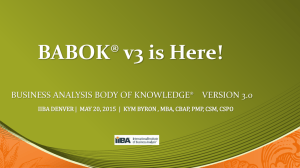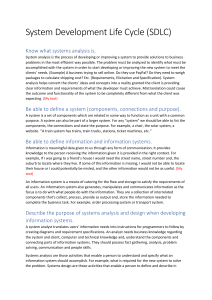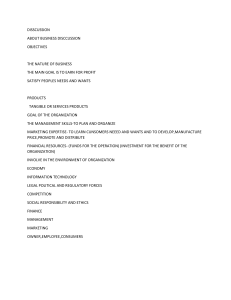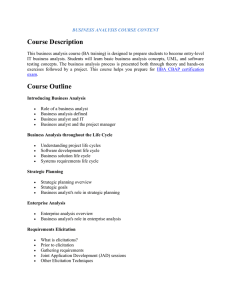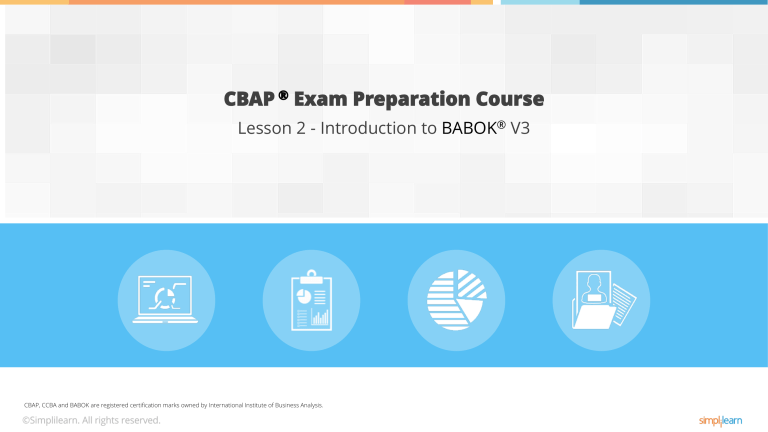
CBAP ® Exam Preparation Course Lesson 2 - Introduction to BABOK® V3 CBAP, CCBA and BABOK are registered certification marks owned by International Institute of Business Analysis. WHAT’S IN IT FOR ME What is business analysis? What does a business analyst do? Business Analysis Core Concept Model Model TM — the Knowledge Areas defined in BABOK® Version 3 What are the underlying competencies of a business analyst? Techniques and perspectives in business analysis INTRODUCTION – WHY BUSINESS ANALYSIS INTRODUCTION – WHY BUSINESS ANALYSIS (contd.) Lesson 2: Introduction to BABOK® V3 Topic 2.1: Key Concepts of Business Analysis ✓ ✓ ✓ ✓ ✓ ✓ Who is a Business Analyst? Business Analysis Core Concept Model Business Analysis Knowledge Areas Defect per Unit Requirements classification Requirements and Design Who is a Stakeholder? BUSINESS ANALYSIS WHAT IS BUSINESS ANALYSIS Where? Define Needs Why? Enable When? Business Analysis Recommend Solutions BUSINESS ANALYSIS WHO IS A BUSINESS ANALYST Elicits the needs from stakeholders Investigates and clarifies stakeholder desires Discovers, synthesizes, and analyzes information Performs tasks defined in the BABOK® Guide Determines issues and their causes BUSINESS ANALYST BUSINESS ANALYSIS BUSINESS ANALYSIS CORE CONCEPT MODEL TM Change Need Solution A problem or opportunity A group or individual related to a change, need, or solution Way to satisfy one or more needs in a context Circumstances that influence or are influenced by, and provide Context understanding of change Stakeholder Usefulness to a stakeholder within a context The act of transformation in response to need Value BUSINESS ANALYSIS BODY OF KNOWLEDGE KNOWLEDGE AREAS 1. Business Analysis Planning and Monitoring 2. Elicitation and Collaboration 3. Requirements Lifecycle Management 4. Strategy Analysis 5. Requirements Analysis and Design Definition 6. Solution Evaluation BUSINESS ANALYSIS BODY OF KNOWLEDGE (contd.) KNOWLEDGE AREAS 1. Business Analysis Planning and Monitoring 2. Elicitation and Collaboration 3. Requirements Lifecycle Management 4. Strategy Analysis 5. Requirements Analysis and Design Definition 6. Solution Evaluation It describes the tasks to be performed to organize and co-ordinate the effort of business analysts and stakeholders. Output from this knowledge area tasks is used as a key input or as guidelines for the tasks performed in other knowledge areas. BUSINESS ANALYSIS BODY OF KNOWLEDGE (contd.) KNOWLEDGE AREAS 1. Business Analysis Planning and Monitoring 2. Elicitation and Collaboration 3. Requirements Lifecycle Management 4. Strategy Analysis 5. Requirements Analysis and Design Definition 6. Solution Evaluation It describes the tasks to be performed to prepare for elicitation, conduct the elicitation activity, and confirm elicitation results. It also explains how communication of business analysis information and ongoing collaboration must be done with the stakeholder. BUSINESS ANALYSIS BODY OF KNOWLEDGE (contd.) KNOWLEDGE AREAS 1. Business Analysis Planning and Monitoring 2. Elicitation and Collaboration 3. Requirements Lifecycle Management 4. Strategy Analysis 5. Requirements Analysis and Design Definition 6. Solution Evaluation It describes the tasks to be performed to manage and maintain requirements and design information from inception to retirement. BUSINESS ANALYSIS BODY OF KNOWLEDGE (contd.) KNOWLEDGE AREAS 1. Business Analysis Planning and Monitoring 2. Elicitation and Collaboration 3. Requirements Lifecycle Management 4. Strategy Analysis 5. Requirements Analysis and Design Definition 6. Solution Evaluation It describes the tasks to be performed for collaboration with the stakeholder to identify the real need and enable the organization to address that need. It also explains the tasks to align the resulting strategy for the change with higher- and lower-level strategies to address the need. BUSINESS ANALYSIS BODY OF KNOWLEDGE (contd.) KNOWLEDGE AREAS 1. Business Analysis Planning and Monitoring 2. Elicitation and Collaboration 3. Requirements Lifecycle Management 4. Strategy Analysis 5. Requirements Analysis and Design Definition 6. Solution Evaluation It describes the tasks to be performed to structure and organize requirements discovered during the elicitation activity, specify and model requirements and design, validate and verify information, and identify solution options that meet the business need. BUSINESS ANALYSIS BODY OF KNOWLEDGE (contd.) KNOWLEDGE AREAS 1. Business Analysis Planning and Monitoring 2. Elicitation and Collaboration 3. Requirements Lifecycle Management 4. Strategy Analysis 5. Requirements Analysis and Design Definition 6. Solution Evaluation It describes the tasks to be performed to assess the performance of and value delivered by a solution and recommend actions to be taken to realize the full value of the solution. BUSINESS ANALYSIS BODY OF KNOWLEDGE KNOWLEDGE AREAS – RELATIONSHIPS Business Analysis Planning and Monitoring Requirements Analysis and Design Definition Strategy Analysis Requirements Lifecycle Management Elicitation and Collaboration Solution Evaluation REQUIREMENTS REQUIREMENTS CLASSIFICATION Statements of goals, objectives, and outcome that describe why a change has been initiated Business Requirements Describe the capabilities and qualities of a solution that meets stakeholder requirements; can be Functional requirements or Nonfunctional requirements Solution Requirements Stakeholder Requirements Describe the needs of the stakeholders that must be met to achieve the business requirements Transition Requirements Describe the capabilities that the solution must have to facilitate transition of the organization from the current state to the future state REQUIREMENTS (contd.) REQUIREMENTS DOCUMENTS BRD Requirements Requirements Documents Documents Business Requirements Documents that comprise both business and stakeholder requirements FSD Functional Specification Document SRS Solution Requirements Specification REQUIREMENTS AND DESIGN DESIGN CYCLE Requirements lead to design. Requirements may be used to define design. Requirements are focused on needs and design is focused on the solution. Needs Requirements Design Requirements and design could be recursive. A Business Analyst reviews designs to ensure they align with the requirements. Solution BABOK® GUIDE SPECIFICATIONS STAKEHOLDERS A stakeholder is an individual or group that a Business Analyst is likely to interact with directly or indirectly. Supplier Domain SME Tester Customer Sponsor Business Analyst End User Regulator Project Manager Operational Support Implementation SME Lesson 2: Introduction to BABOK® V3 Topic 2.2: Competencies of a Business Analyst ✓ Competencies of a business analyst Defect per Unit COMPETENCIES OF A BUSINESS ANALYST CATEGORIES Business Knowledge (5) Communication Skills (4) Behavioral Characteristics (5) Interaction Skills (5) Competencies Analytical Thinking and ProblemSolving Skills (7) Tools and Technology (3) COMPETENCIES OF A BUSINESS ANALYST (contd.) ANALYTICAL THINKING AND PROBLEM SOLVING Analytical Thinking and Problem-Solving Skills Creative Thinking Ability to generate new ideas and approaches to solve problems Learning Ability to quickly absorb new and different types of information Conceptual Thinking Ability to understand how disparate information fits into a larger picture Decision Making Ability to understand the criteria needed to make decisions Problem Solving Ability to understand the underlying cause of a problem and use problemsolving techniques Visual Thinking Ability to visually communicate complex concepts and models to stakeholders System Thinking Ability to understand the interactions between people, process, and technology COMPETENCIES OF A BUSINESS ANALYST (contd.) BEHAVIORAL CHARACTERISTCS Behavioral Characteristics Ethics Enable a business analyst to earn the respect of stakeholders Personal Accountability Enables a business analyst to achieve target goals Trustworthiness Perception that one is worthy of trust Organization and Time Management Helps perform tasks effectively and use work time efficiently Adaptability Ability to adjust behavioral style, methods, and approach to the environment COMPETENCIES OF A BUSINESS ANALYST (contd.) BUSINESS KNOWLEDGE Business Knowledge Business Acumen Ability to understand business principles and practices and apply them at work Organization Knowledge Understanding the management structure and the business architecture of the enterprise Industry Knowledge Understanding how a company is positioned within an industry Solution Knowledge Competencies Understanding solutions that will help expedite the discovery of potential changes through elicitation Methodology Knowledge Enables a business analyst to quickly adapt to, and perform in, a new environment COMPETENCIES OF A BUSINESS ANALYST (contd.) COMMUNICATION SKILLS Communication Skills Verbal Communication Used to convey ideas, concepts, facts, and opinions to stakeholders Communication skills refers to the ability to communicate effectively. Competencies Written Communication Practice of using text, symbols, models, pictures, or sketches to convey and share information Nonverbal Communication Enables sending and receiving messages through body movements, postures, facial expressions, gestures, and eye contact Listening Enables accurate understanding of verbal communication COMPETENCIES OF A BUSINESS ANALYST (contd.) INTERACTION SKILLS Interaction Skills Leadership and Influencing Involves motivating people to act in ways that enable them to work together Facilitation Ability to moderate discussions within a group Interaction Skills include the ability to relate to and co-operate and communicate with different kinds of people. Teamwork Enables working with team members effectively Negotiation Competencies Involves mediating discussions and resolving differences in teams Teaching Enables a business analyst to effectively communicate business information, concepts, ideas, and issues COMPETENCIES OF A BUSINESS ANALYST (contd.) TOOLS AND TECHNOLOGY SKILLS Tools and Technology Skills Office Productivity Helps document and track information and artifacts Business Analysis Helps model, diagram, document, and manage the output of business analysis activities Competencies A business analyst uses a variety of software to support communication and collaboration, create and maintain requirement artifacts, and increase overall productivity. Communication Helps perform business analysis activities, manage teams, and collaborate with stakeholders Lesson 2: Introduction to BABOK® V3 Topic 2.3: Business Analysis Techniques ✓ Techniques referred to by BABOK V3 Defect per Unit BUSINESS ANALYSIS TECHNIQUES 50 TECHNIQUES 10.1 Acceptance and Evaluation Criteria 10.11 Concept Modelling 10.21 Focus Groups 10.31 Observation 10.41 Scope Modelling 10.2 Backlog Management 10.12 Data Dictionary 10.22 Functional Decomposition 10.32 Organizational Modelling 10.42 Sequence Diagrams 10.3 Balanced Scorecard 10.13 Data Flow Diagrams 10.23 Glossary 10.33 Prioritization 10.43 Stakeholder List, Map, or Personas 10.4 Benchmarking and Market Analysis 10.14 Data Mining 10.24 Interface Analysis 10.34 Process Analysis 10.44 State Modelling 10.5 Brainstorming 10.15 Data Modelling 10.25 Interviews 10.35 Process Modelling 10.6 Business Capability Analysis 10.45 Survey or Questionnaire 10.16 Decision Analysis 10.26 Item Tracking 10.36 Prototyping 10.46 SWOT Analysis 10.7 Business Cases 10.17 Decision Modelling 10.27 Lessons Learned 10.37 Reviews 10.8 Business Model Canvas 10.18 Document Analysis 10.28 Metrics and Key Performance Indicators Competencies (KPIs) 10.47 Use Cases and Scenarios 10.38 Risk Analysis and Management 10.48 User Stories 10.9 Business Rules Analysis 10.19 Estimation 10.29 Mind Mapping 10.39 Roles and Permissions Matrix 10.49 Vendor Assessment 10.10 Collaborative Games 10.20 Financial Analysis 10.30 Non functional Requirements Analysis 10.40 Root Cause Analysis 10.50 Workshops Lesson 2: Introduction to BABOK® V3 Topic 2.4: Business Analysis Perspectives ✓ Business Analysis perspectives Defect per Unit BUSINESS ANALYSIS PERSPECTIVES FIVE BUSINESS ANALYSIS PERSPECTIVES Perspectives provide focus to tasks and techniques specific to the context of an initiative. Perspectives are not mutually exclusive. Most initiatives are likely to engage one or more perspectives. BABOK® includes five perspectives. Agile Business Intelligence Competencies Information Technology Business Architecture Business Process Management BUSINESS ANALYSIS PERSPECTIVES (contd.) FIVE BUSINESS ANALYSIS PERSPECTIVES Agile Business Intelligence Information Technology An Agile initiative involves: • An agile mindset • Agile values and principles Competencies • Progressive elaboration of business planning, elicitation, analysis, design, and construction of solution A Business Analyst is an active member of an Agile team. Business Architecture Business Process Management BUSINESS ANALYSIS PERSPECTIVES (contd.) FIVE BUSINESS ANALYSIS PERSPECTIVES Agile Business Intelligence Information Technology Business Architecture Business Intelligence: • Highlights the characteristics of business analysis in the context of transformation, integration, and enhancing data Competencies • Is the transformation of data into valuable information • Helps stakeholders make informed decisions • Helps stakeholders manage strategic, tactical, and operational performance Business Process Management BUSINESS ANALYSIS PERSPECTIVES (contd.) FIVE BUSINESS ANALYSIS PERSPECTIVES Agile Business Intelligence Information Technology Business Architecture Information Technology: • This perspective highlights the characteristics of business analysis in the context of the Competencies impact of change on IT systems in an organization. • Organizations need to undertake initiatives to upgrade or replace IT systems. • A business analyst plays the role of a translator between business and technology teams in the change process. Business Process Management BUSINESS ANALYSIS PERSPECTIVES (contd.) FIVE BUSINESS ANALYSIS PERSPECTIVES Agile Business Intelligence Information Technology Business Architecture Business Architecture: • Highlights the unique characteristics of business analysis in the context of business Competencies architecture • Involves analytical thinking and applying architectural principles at the enterprise level • Supports ongoing business transformation efforts • Could include changes to business, operational model, or structure Business Process Management BUSINESS ANALYSIS PERSPECTIVES (contd.) FIVE BUSINESS ANALYSIS PERSPECTIVES Agile Business Intelligence Information Technology Business Architecture Business Process Management Business Process Management: • Highlights the characteristics of business analysis in the context of developing or Competencies improving business processes • Focuses on how an organization works across multiple functional areas to improve business processes • Is an integral part of ongoing management and operations of an organization Quiz QUIZ 1 a. Which of the following is NOT a component of the Business Analysis Core Concept Model TM (BACCMTM)? Change b. Solution c. Content d. Stakeholder QUIZ 1 a. Which of the following is NOT a component of the Business Analysis Core Concept Model TM (BACCMTM)? Change b. Solution c. Content d. Stakeholder The correct answer is c. Explanation: Content is not a component of Business Analysis Core Concept Model TM (BACCM). The components are Change, Need, Solution, Stakeholder, Value, and Context. QUIZ 2 a. _____ are focused on the needs, and _____ are focused on the solution. Problems; Requirements b. Requirements; Designs c. Solutions; Requirements d. Designs; Requirements QUIZ 2 a. _____ are focused on the needs, and _____ are focused on the solution. Problems; Requirements b. Requirements; Designs c. Solutions; Requirements d. Designs; Requirements The correct answer is b. Explanation: According to the Requirements and Design Cycle, Requirements are focused on the needs and Designs are focused on the solution. QUIZ 3 a. Which of the following is a business analysis knowledge area? Elicitation and Collaboration b. Enterprise Analysis c. Solution Assessment and Validation d. Requirements Analysis and Management QUIZ 3 a. Which of the following is a business analysis knowledge area? Elicitation and Collaboration b. Enterprise Analysis c. Solution Assessment and Validation d. Requirements Analysis and Management The correct answer is a. Explanation: Elicitation and Collaboration is one of the business analysis knowledge areas. . QUIZ 4 a. Which of the following is NOT a category of business analyst competencies as defined in BABOK®? Analytical Thinking and Problem Solving b. Communication c. Organizational Knowledge d. Interaction QUIZ 4 a. Which of the following is NOT a category of business analyst competencies as defined in BABOK®? Analytical Thinking and Problem Solving b. Communication c. Organizational Knowledge d. Interaction The correct answer is c. Explanation: Organizational Knowledge is not a category of business analyst competencies. It is, in fact, a core competency of the Business Knowledge category. KEY TAKEAWAYS A business analyst is a person who performs business analysis tasks described in the BABOK® Guide. Business analysis is the practice of enabling change in an enterprise by defining needs and recommending solutions that deliver value to stakeholders. The Business Analysis Core Concept Model TM (BACCMTM) defines the conceptual framework for the practice of business analysis. The BABOK® Guide groups business analysis tasks into six knowledge areas. The BABOK® GUIDE describes 29 business analysis competencies, 50 techniques, and 5 perspectives. This concludes Introduction to BABOK® V3. The next lesson is “Business Analysis Planning and Monitoring.” THANK YOU

